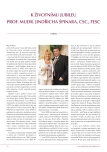Sudden cardiac death prevention in acute myocardial infarction
Authors:
J. Bytešník
Authors‘ workplace:
Odd. arytmologie na Klinice kardiologie IKEM
Published in:
Kardiol Rev Int Med 2010, 12(Supplementum): 13-16
Overview
The onset of early reperfusion therapy has been linked to decreased incidence of MI-associated sudden cardiac death. The risk of sudden death remains high under certain clinical conditions, particularly in the presence of heart failure. At the early phase of the coronary event, ECG monitoring and immediate external defibrillation of the ventricular fibrillation, the main cause of sudden cardiac death, are crucial. Reliable risk stratification for the periods shortly after the acute myocardial infarction, to support the indication for implantable cardioverter- defibrillator, has so far been missing. In addition to the detection and management of serious arrhythmias, an effective treatment of heart failure and myocardial tissue protection against sympathetic- adrenergic reaction – with beta-blockers – from the earliest stages of AMI also play an important role.
Keywords:
sudden cardiac death – atrial fibrillation – defibrillation – acute coronary syndrome
Sources
1. Myerburg RJ, Interian A jr, Simmons J et al. Sudden Cardiac Death. In: Zipes DP, Jalife J (eds). Cardiac Electrophysiology. From cell to bedside. Philadelphia: Saunders 2004, 720–731.
2. Zipes PD, Camm AJ, Borggrefe M et al. ACC/ AHA/ESC Guidelines for management of patients with ventricular arrhythmias and the prevention of sudden cardiac death. J Am Coll Cardiol 2006; 48: 1064–1108.
3. Mehta D, Curwin J, Gomes A et al. Sudden death in coronary artery disease: Acute ischemia versus myocardial substrate. Circulation 1997; 96: 3215–3223.
4. Taylor AJ, Burke AP, O´Malley PG et al. A comparison of the Framingham risk index, coronary artery calcification, and culprit plaque morphology in sudden cardiac death. Circulation 2000; 101: 1243–1248.
5. Pantridge JF, Geddes JS. A mobile intensive care unit in the management of myocardial infarction. Lancet 1967; 2: 271–273.
6. Lown B, Fakhro AM, Hood WB et al. The coronary care unit: New perspectives and directions. JAMA 1967; 199: 188–198.
7. Carmeliet F. Cardiac ionic currents and acute ischemia: From channels to arrhythmia. Phys Rev 1999; 79: 917–1017.
8. Bytešník J. Mechanizmy vzniku arytmií. In: Aschermann M (ed.). Kardiologie. Praha: Galén 2004: 1085–1099.
9. Peters NS, Witt AL. Gap junction remodeling in infarction: does it play a role in arrhythmogenesis? J Cardiovasc Electrophysiol 2000; 11: 488–490.
10. Van de Werf F, Bax J, Betriu A et al. Task Force of the ESC: Acute myocardial infarction in patients presenting with ST-segment elevation. Eur Heart J 2008; 29: 2909–2945.
11. Bělohlávek J, Aschermann M. Doporučený postup pro diagnostiku a léčbu akutních koronárních syndromů bez elevací ST úseků na ekg. Cor Vasa 2008; 50 (Suppl.): 1S7–1S23.
12. Cummins RO, Ornato JP, Thies WH et al. Improving survival from sudden cardiac arrest: The „chain of survival“ concept: a statement for health professionals from the Advanced Life Support subcommittee and the Emergency Cardiac Care Committee, AHA. Circulation 1991; 83: 1832–1847.
13. European Resuscitation Council. ERC Guidelines for resuscitation 2005. Resuscitation 2005; 67: S3–S189.
14. El-Sherif N, Myerburg RJ, Sherlag BJ et al. Electrocardiographic antecedents of primary ventricular fibrillation: value of the R-on-T phenomenon in myocardial infarction. Br Heart J 1976; 38: 415–422.
15. Vojáček J, Rozsíval V, Kolář J et al. Ischemická srdeční choroba. In: Vojáček J, Kettner J (eds). Klinická kardiologie. Hradec Králové: Nucleus HK 2009: 95–207.
16. Henkel DM, Witt BJ, Gersh BJ et al. Ventricular arrhythmias after acute myocardial infarction: a 20-year community study. Am Heart J 2006; 151: 806–812.
17. The Cardiac Arrhythmia Suppression Trial (CAST) Investigators. Preliminary report: effect of encainide and flecaainide on mortality in a randomized trial of arrhythmia suppression after myocardial infarction. N Engl J Med 1989; 321: 406–412.
18. Teo KK, Yusuf S, Furberg CD. Effects of prophylactic antiarrhythmic drug therapy in acute myocardial infarction. An overview of results from randomized controlled trials. JAMA 1993; 270: 1589–1595.
19. Mac Mahon S, Collins R, Peto R et al. Effects of prophylactic lidocain in suspected acute myocardial infarction: an overview of results from the randomized controlled trials. JAMA 1988; 260: 1910–1916.
20. Hine LK, Laird N, Hewitt P, et al. Meta-analytic evidence against profylactic use of Lidocaine in acute myocardial infarction. Arch Intern Med 1989; 149: 2694–2698.
21. Adabag AS, Therneau TM, Gersh BJ et al. Sudden death after myocardial infarction. infarction. JAMA 2008; 300: 2022–2029.
22. Fejfar Z, Vrána M. Prevence náhlé koronární smrti svépomocí. Vnitřní Lék 1992; 38: 937–944.
23. Hjalmarson A, Herlitz J, Holmberg S et al. Tle Goteborg metoprolol trial: Effects on mortality and morbidity in acute myocardial infarction. Circulation 1983; 67: I26–I32.
24. Norris RM, Barnaby PF, Brown PM et al. Prevention of ventricular fibrillation during acute myocardial infarction by intravenous propranolol. Lancet 1984; 2: 883.
25. Ideker RE, Juany J, Walcott GP. Defibrillation waveforms. In: Zipes DP, Jalife J (eds). Cardiac Electrophysiology. From Cell to bedside. Philadelphia: Saunders 2004: 426–432.
26. Lenderink T, Hernández AV, Boersma E et al. Prediction of 30-day mortality in older patients with a first acute myocardial infarction. Cardiology 2010; 115: 1–9.
27. Honzák R, Staněk V, Pokorný J et al. Emoce a psychické poruchy při infarktu myokardu – jejich diagnostika a léčba. Farmakoterapie 2009; 5: 550–600.
Labels
Paediatric cardiology Internal medicine Cardiac surgery CardiologyArticle was published in
Cardiology Review

2010 Issue Supplementum
Most read in this issue
- Bradycardia in acute myocardial infarction
- Cardiopulmonary resuscitation: annotated ERC Guidelines 2005
- Supraventricular arrhythmia in acute myocardial infarction
- Sudden cardiac death prevention in acute myocardial infarction
